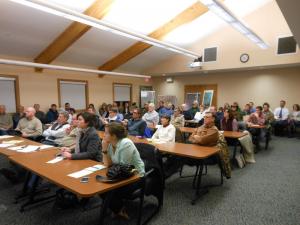Aquaculture workshop offers answers, raises new questions
Dagsboro resident Terry Murray would love to try his hand at oyster farming, but a recent public workshop did little to ease his concerns over how Delaware's new aquaculture program is going to work.
Murray doesn't like the idea that a Delaware waterman with a proven track record of success will receive no preference when it comes to leasing land.
Raising the issue at a Feb. 26 workshop in Lewes, Murray asked state officials, “Why shouldn't the watermen get the first crack at it?” A waterman who has been fishing the Indian River Bay his whole life, he said, “I'm just worried that this program is not put together 100 percent.”
Murray questions the process. If you're a watermelon farmer or raise cattle, you're going to get the same opportunity as an experienced waterman, he said, speaking to Delaware Department of Natural Resources and Environmental Control representatives at the meeting.
Legislation creating shellfish aquaculture in Delaware was passed last year and DNREC is in the first stages of creating rules and regulations to implement the program.
Leases will be sold by the state to farm in Rehoboth, Indian River and Little Assawoman bays.
Murray was one of more than 50 people who attended a DNREC-sponsored workshop on the new program. This was the second workshop, and its purpose was to garner public comment.
Murray was the most vocal and raised the most concerns over potential issues.
“I'm going to bite the bullet and speak for the other watermen in here,” he said. “If the state of Delaware is going to do aquaculture, why not get all the way involved?”
Stewart Michels, DNREC fisheries program manager, and Zina Hense, DNREC environmental scientist, did their best to answer his questions, but both reiterated many answers are not yet available.
Information that was available included leasing costs, total leased acreage allowed per applicant, the total percentage of bay land available for farming, and the species of shellfish allowed to be farmed.
Hense also presented information comparing start-up costs in Virginia and North Carolina that suggest an applicant can expect to spend between $40,000 and $60,000. She said these costs were just estimates and they could vary significantly depending on a handful of things, such as whether the applicant already has a boat or has the ability to built oyster cages.
The Center for the Inland Bays has identified locations in each of the three bays that would be suitable for shellfish farming called Shellfish Aquaculture Development Areas.
In Rehoboth Bay, there are 260 acres among three locations that represent 4.3 percent of the total bay area. In Indian River Bay, there are 125 acres in two locations, representing 1.36 percent of total bay area. In Little Assawoman Bay, there are 227 acres among four locations that represent 9.3 percent of total bay area.
Michels said the goal is to streamline the process for applicants who want to farm in these identified areas, saying permits would almost be rubber-stamped as long as the applicant fits the criteria.
Farmers can raise shellfish outside the development areas, but a lot of the burden will be on them, Michels said, specifically pointing to getting approval from the U.S. Army Corp of Engineers and DNREC wetland permits.
Increasing recreational traffic on the bays was an issue brought up by numerous people, but that issue didn't concern everyone.
Billy Lucas of Dewey Beach grew up on the waters of Rehoboth Bay, which is where he would like to get a lease.
“It's so shallow right there. There's not going to be a boating problem,” he said.
Lucas is excited about the opportunity to farm shellfish in Rehoboth Bay.
“I think we'll be able to grow oysters in there. It would be great,” he said. “The problem is, I think everyone is going to figure that out also and want to go there too.”
The next step in the shellfish farming program is the formal regulation process, which requires public notices and public hearings.
Michels wasn't sure when then process would start.
“It's a matter of converting the comments we've received into draft regulations, and I'm not certain how long it will take us. There's still a lot of work to do,” he said.
Dave Saveikis, DNREC Division of Fish & Wildlife director, said the goal is to have the program in place by this summer and to begin accepting lease applications by July.
Aquaculture by the numbers:
• Minimum lease acreage is one acre and the maximum any one applicant can apply for is five acres within Rehoboth and Indian River bays combined. An applicant who leases up to five acres in Rehoboth and/or Indian River bay may also lease an additional one to five acres in Little Assawoman Bay.
• The application fee for an aquaculture lease is $300. The annual fee for a lease is $100 an acre for a Delaware resident and $1,000 an acre for a nonresidents.
• Initially farmers will be permitted to harvest the Eastern oyster in all three bays and hard clams in Little Assawoman Bay.
• Leases issued in Rehoboth and Indian River bays will not exceed 5 percent of the total subaqueous lands within each bay. In Little Assawoman Bay, the maximum allowable acreage for leasing will not exceed 10 percent of the subaqueous lands.
Chris Flood has been working for the Cape Gazette since early 2014. He currently covers Rehoboth Beach and Henlopen Acres, but has also covered Dewey Beach and the state government. He covers environmental stories, business stories and random stories on subjects he finds interesting, and he also writes a column called Choppin’ Wood that runs every other week. He’s a graduate of the University of Maine and the Landing School of Boat Building & Design.





















































